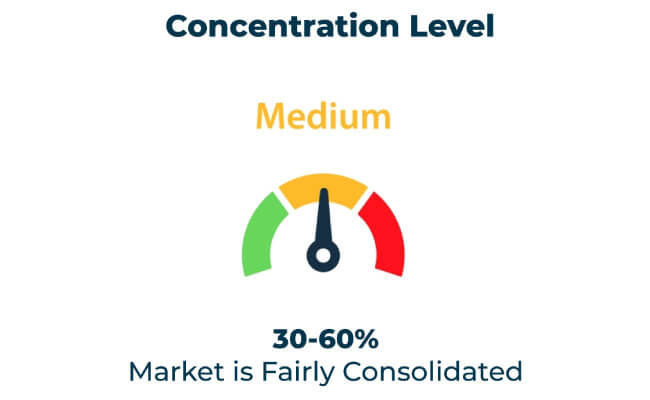The tarpaulin sheets market is growing steadily as industries and consumers demand versatile, durable, and eco-friendly solutions for protection and coverage. Manufacturers are creating innovative tarpaulin sheets with advanced materials, lightweight designs, and sustainable practices to serve sectors like agriculture, construction, logistics, and consumer goods. By 2035, this market is projected to exceed USD 14.3 billion, growing at a compound annual growth rate (CAGR) of 4.7%.
The focus on cost efficiency, durability, and environmental sustainability is driving market growth. Companies prioritize delivering customizable and long-lasting tarpaulin sheets that meet the unique requirements of diverse industries and environments.
| Attribute | Details |
|---|---|
| Projected Value by 2035 | USD 14.3 billion |
| CAGR during the period 2025 to 2035 | 4.7% |
Factors Driving Market Growth
| Category | Market Share (%) |
|---|---|
| Top 3 Players (SRF Limited, Heytex, Sioen) | 15% |
| Rest of Top 5 Players (Puyoung, Naizil) | 09% |
| Next 5 of Top 10 Players | 07% |
Type of Player & Industry Share
| Type of Player | Market Share (%) |
|---|---|
| Top 10 Players | 31% |
| Next 20 Players | 40% |
| Remaining Players | 29% |

Year-on-Year Leaders
Emerging markets in Asia-Pacific, Africa, and Latin America present vast growth opportunities. Rising construction and agricultural activities, combined with the growing need for protective solutions, drive demand for high-quality tarpaulin sheets. Exporters that align with local standards and preferences can tap into these expanding markets.
In-House vs. Contract Packaging
| Region | North America |
|---|---|
| Market Share (%) | 30% |
| Key Drivers | Sustainability and industrial demand drive growth. |
| Region | Europe |
|---|---|
| Market Share (%) | 35% |
| Key Drivers | Recycling infrastructure and green policies boost demand. |
| Region | Asia-Pacific |
|---|---|
| Market Share (%) | 25% |
| Key Drivers | Industrialization and agriculture propel market expansion. |
| Region | Other Regions |
|---|---|
| Market Share (%) | 10% |
| Key Drivers | Durable, affordable solutions gain traction in emerging markets. |
The tarpaulin sheets market will grow through advancements in sustainable materials, smart technologies, and automation. Companies that focus on innovation, emerging markets, and partnerships with key industries will strengthen their competitive positions. Global trade and sustainability goals will drive further market expansion.
| Tier | Key Companies |
|---|---|
| Tier 1 | SRF Limited, Heytex, Sioen |
| Tier 2 | Puyoung, Naizil |
| Tier 3 | Fulin Plastic, Veer Plastics |
The tarpaulin sheets market is poised for sustained growth as sustainability, innovation, and industrial demand shape its trajectory. Companies investing in eco-friendly practices, advanced technologies, and global market opportunities will lead the way. Collaboration with industry partners and continued advancements in recycling will further enhance the market's prospects.
Key Definitions
Abbreviations
Methodology
This report integrates primary research, secondary data, and expert insights. Analysts validated findings through interviews with industry professionals and end-users to ensure reliable and actionable insights.
Market Definition
The tarpaulin sheets market includes the production and use of versatile, durable, and sustainable covers for industries such as construction, agriculture, logistics, and consumer goods. These sheets prioritize durability, customization, and environmental sustainability.
Tarpaulin sheets are widely used for construction site covers, agricultural crop protection, logistics cargo covers, and outdoor applications like camping and home improvement.
Manufacturers use recyclable materials, biodegradable plastics, and energy-efficient production methods to create sustainable tarpaulin sheets.
Europe and North America lead the market due to their advanced recycling infrastructure and strong demand for durable, sustainable solutions.
High material costs, gaps in recycling infrastructure, and varying regulatory requirements are some of the major challenges.
Customization allows manufacturers to meet specific industry needs, such as tailored sizes, colors, and functional features, enhancing their market appeal.






Full Research Suite comprises of:
Market outlook & trends analysis
Interviews & case studies
Strategic recommendations
Vendor profiles & capabilities analysis
5-year forecasts
8 regions and 60+ country-level data splits
Market segment data splits
12 months of continuous data updates
DELIVERED AS:
PDF EXCEL ONLINE
Tarpaulin Sheet Industry Analysis in Western Europe Size and Share Forecast Outlook 2025 to 2035
Tarpaulin Sheet Industry Analysis in Korea Size and Share Forecast Outlook 2025 to 2035
Tarpaulin Sheet Industry Analysis in Japan Size and Share Forecast Outlook 2025 to 2035
Tarpaulin Sheets Market Size and Share Forecast Outlook 2025 to 2035
Mesh Tarpaulin Sheets Market Size and Share Forecast Outlook 2025 to 2035
Hoarding tarpaulin Market
UV Protected Tarpaulin Sheets Market Size and Share Forecast Outlook 2025 to 2035
Asia Pacific and Europe Tarpaulin Sheets Market Size and Share Forecast Outlook 2025 to 2035
Slip Sheets Market Insights – Growth & Demand 2025 to 2035
Dryer Sheets Market Size and Share Forecast Outlook 2025 to 2035
Veneer Sheets Market Size and Share Forecast Outlook 2025 to 2035
Mirror Sheets Market Size and Share Forecast Outlook 2025 to 2035
Aluminum Sheets and Coils Market Size and Share Forecast Outlook 2025 to 2035
Greaseproof Sheets Market Size and Share Forecast Outlook 2025 to 2035
Replacement Sheets Market Analysis - Size, Share & Forecast 2025 to 2035
Market Share Insights for Greaseproof Sheets Providers
Cast Acrylic Sheets Market Size and Share Forecast Outlook 2025 to 2035
TPE Films and Sheets Market Size and Share Forecast Outlook 2025 to 2035
Push-Pull Slip Sheets Market Size, Share & Forecast 2025 to 2035
Disposable Bed Sheets Market Analysis - Trends, Growth & Forecast 2025 to 2035

Thank you!
You will receive an email from our Business Development Manager. Please be sure to check your SPAM/JUNK folder too.
Chat With
MaRIA